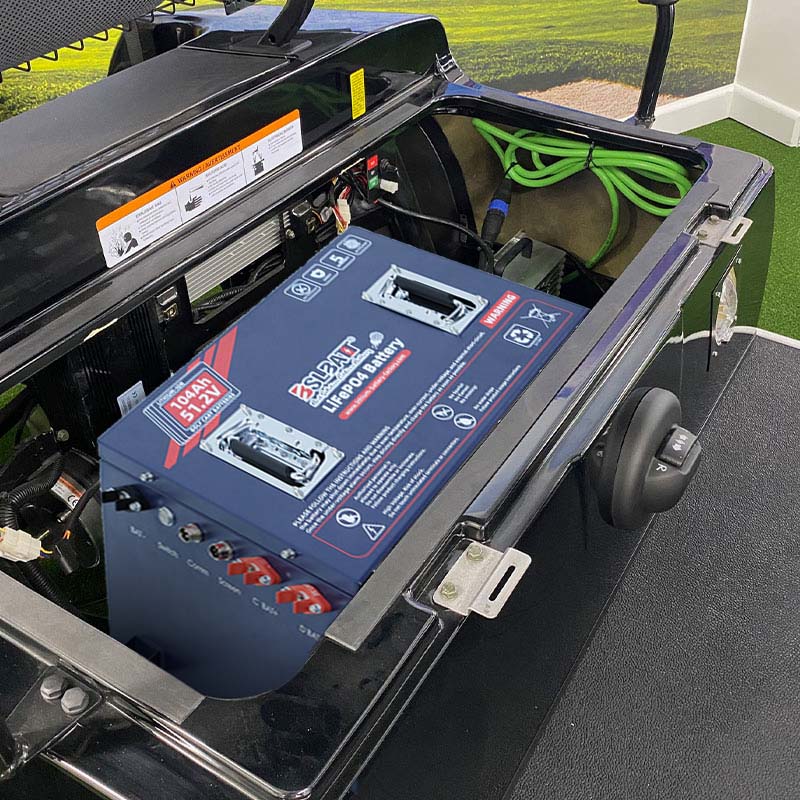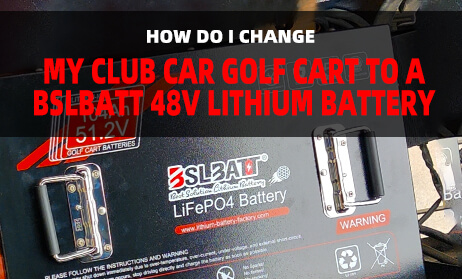Industry Application
Product Type
Testing Golf Cart Batteries Made Easy: Tips and Techniques

Having the appropriate tools is crucial when it comes to testing testing a golf cart battery. In this comprehensive guide on how to test golf cart batteries, we will provide you with a detailed walkthrough of the essential steps required to effectively test your golf cart battery using a variety of methods and equipment. By following these instructions, you will be able to accurately assess the condition of your golf cart battery and ensure its optimal performance.
How to know when golf cart batteries are dying?
There are several indicators to be aware of when the batteries you possess start to lose their power. If you have diligently followed our instructions on battery maintenance, you should be pleased with the extended period of usage you have obtained from them.
In most golf carts, you will find a voltage meter conveniently located on the dashboard. The most accurate meter is an analog one, which provides a direct reading of the battery’s condition. While an electric gauge is better than having no gauge at all, it is not as reliable. As the batteries near the end of their lifespan, their ability to accelerate rapidly after a full charge diminishes, and there may be subtle signs of reduced range. Moreover, you will notice a significant increase in the charging time required for the batteries. If you are genuinely interested in evaluating the performance of your batteries, they can also undergo testing.
By paying attention to these indicators, you can effectively monitor the power level of your batteries and take appropriate action when necessary.
Indicators of Golf Cart Battery Failure
In order to ascertain whether a golf cart battery is no longer functional or approaching the end of its useful life, it is advisable to conduct a battery test. Nevertheless, there are a number of significant indicators of battery deterioration that can be detected before conducting the test.
Slow Battery Charge
If the golf cart is taking an extended period of time to charge, it could be an indication that the internal chemicals have surpassed their expected lifespan or that a specific component has deteriorated. This is a significant warning sign that should not be ignored, as it could lead to further issues with the golf cart’s performance. It is important to address this issue promptly to ensure the longevity and efficiency of the golf cart.
Quick Discharge
On the other hand, if the battery starts to lose its charge at a faster rate than it did previously, this serves as a clear indication that the battery is gradually deteriorating. For instance, a golf cart that used to effortlessly complete multiple rounds on a single charge may now face difficulties in completing even just one or two rounds. This decline in the range of the golf cart is a notable and concerning red flag, signaling the worsening condition of the battery.
Sluggish Acceleration
However, electric golf carts are generally known for their impressive acceleration and high torque. If you notice that your electric golf cart is not performing as well as it used to, despite pressing the pedal down hard, it may be time to check the batteries. This is because the batteries are the main source of power for electric golf carts, and if they are not functioning properly, it can affect the cart’s acceleration and overall performance.

Causes of Golf Cart Battery Failure
There are several factors that can contribute to the potential failure of golf cart batteries, as they are prone to different forms of wear and tear. These factors include but are not limited to: improper charging and discharging practices, extreme temperatures, overuse or excessive load on the batteries, and inadequate maintenance. Improper charging and discharging practices, such as undercharging or overcharging the batteries, can significantly reduce their lifespan and overall performance. Additionally, exposure to extreme temperatures, whether it be extremely hot or cold conditions, can also have a detrimental effect on the batteries, causing them to deteriorate more quickly. Overuse or subjecting the batteries to excessive load, beyond their recommended capacity, can lead to premature failure as well. Lastly, neglecting regular maintenance tasks, such as cleaning the battery terminals or checking the water levels, can further accelerate the wear and tear on the batteries, ultimately resulting in potential failure.
Battery Age: As batteries age, they naturally experience wear and tear from long-term use, increasing the likelihood of failure.
Overcharge: When individuals replace chargers with more powerful units or opt for more convenient chargers, excessive heat and water loss can occur, leading to battery failure.
Undercharge: Conversely, using a cheaper, lower-power alternative charging equipment can result in problems. This can cause a buildup of lead sulfate, which crystallizes on the battery plates and reduces recharging capacity.
Overtaxing: Extensive use of additional electronic features on the golf cart, such as radios and headlights, can put a strain on the battery. This increased usage can lead to battery failure.
Corrosion: Insufficient levels of electrolytic fluid can lead to corrosion on the battery connections. This corrosion rapidly diminishes the battery’s lifespan.
Incorrect battery: Golf carts are designed to operate with a specific configuration of battery units. For instance, a golf cart may require six 6-volt units. Some individuals attempt to bypass this recommendation by using three 12-volt units. While the math may seem to work, the performance ratings do not align, resulting in battery failure.
How to test golf cart batteries and identify bad batteries
In order to conduct a thorough battery test, it is necessary to utilize a battery discharge tester, which is a costly industrial device. Most reputable golf car dealerships possess this equipment. The process involves charging the batteries to full capacity and then connecting them to the machine. The machine will then draw a consistent amount of energy from the batteries to determine their discharge rate in minutes. This method is the most effective way to identify a faulty battery within a pack. A defective battery can only be detected when a golf cart battery is completely discharged. A 6-volt battery with a bad cell may display 5 volts of charge when under load, but will drop to 2-3 volts when fully discharged. Despite this, the battery may still function normally until it reaches the same low discharge rate.

Factors related to test golf cart battery
Voltmeter, your trusted partner
A voltmeter is a convenient and widely used tool for testing the health of a golf cart battery. By measuring the voltage, it provides valuable information about the overall condition of the battery. To perform the test, you need to connect the positive (red) probe of the voltmeter to the positive terminal of the battery, and the negative (black) probe to the negative terminal. Once connected, the voltmeter will display the voltage of the battery. For a fully charged battery, the reading should ideally be between 12.6 to 12.8 volts. This method is considered one of the most common and straightforward ways to assess the state of a golf cart battery.
Examining each battery individually
If your golf cart battery consists of multiple individual batteries, it’s important to test golf cart battery each one individually. This will help you identify any weak or faulty batteries that may be affecting the overall performance of your golf cart. Using a voltmeter, test the voltage of each battery following the same procedure mentioned earlier. If you notice a significant difference in voltage between the batteries, it may be an indication of a problem.
Hydrometers: Have You Tried One?
The hydrometer is a valuable instrument that can be utilized to measure the specific gravity of the electrolyte in your golf cart battery. By doing so, you can obtain a more precise evaluation of the battery’s current charge status. To employ a hydrometer, simply take off the battery caps and extract a small quantity of electrolyte into the hydrometer. Subsequently, the hydrometer will display the specific gravity of the electrolyte, allowing you to compare it with a chart in order to ascertain the battery’s level of charge.
Using load testers to verify charges
A load tester is an advanced instrument designed to evaluate the capacity and efficiency of your golf cart battery by subjecting it to a simulated load. This tool proves particularly valuable in identifying batteries that are weak or failing, as they may not be easily detected through simple voltage tests. To conduct a load test, you need to connect the load tester to the battery and carefully adhere to the instructions provided by the manufacturer. Once connected, the load tester will apply a load to the battery and measure the resulting voltage drop. If the voltage experiences a significant drop under the load, it could indicate the presence of a weak or faulty battery.
Finding a discharge meter
To obtain a more thorough evaluation of your golf cart battery’s capacity, you can utilize a discharge meter. This tool gauges the battery’s capacity by discharging it at a regulated pace and recording the duration it takes to attain a specific voltage threshold. By contrasting the discharge time with a recognized capacity chart, you can ascertain the battery’s general condition and efficiency.
Guidelines for Safely Test Golf Cart Battery
To ensure safe handling and testing of batteries, it is important to follow certain precautionary measures. Firstly, it is advisable to perform the testing in a well-lit and well-ventilated area. This is because batteries release gases that can be harmful if inhaled, and proper ventilation helps to dissipate these gases effectively.
Secondly, it is crucial to wear appropriate protective gear while handling batteries. This includes rubber gloves, a rubber apron, safety goggles, and closed-toe footwear. These protective measures are necessary to prevent any accidental spills of sulfuric acid, which is present in batteries and can cause severe burns or injuries if it comes into contact with the skin or eyes.
Thirdly, it is of utmost importance to keep all potential sources of ignition away from the battery during testing. This includes sparks, naked flames, or any ignited objects. Even something as seemingly harmless as a lit cigarette or cigar can pose a significant risk, as batteries contain flammable materials that can ignite and cause a fire or explosion.
Lastly, when conducting tests in extreme temperatures, it is essential to ensure that the battery has reached a suitable temperature for accurate readings. It is recommended to wait until the battery temperature reaches at least 20 degrees Celsius or room temperature (68 Fahrenheit) before performing any tests. Additionally, it is crucial to avoid removing the load clamps before concluding the test, as this can result in arcing and potentially lead to a battery explosion.
By following these precautionary measures, the risk associated with handling and testing batteries can be significantly reduced. It is important to prioritize safety and take all necessary steps to protect oneself and others from potential hazards.

In conclusion
test golf cart battery is crucial to ensure optimal performance and longevity. By using tools such as a voltmeter, hydrometer, load tester, and discharge meter, you can accurately assess the health and charge level of your battery. Regular testing and maintenance will help you identify any issues early on and take the necessary steps to keep your golf cart battery in top shape.
If you need any help, please contact us [email protected]
A Guide to Choosing the Best 48V Lithium Golf Cart Battery
Would it be worth investing in a 48V ...
10 Exciting Ways To Use Your 12V Lithium Batteries
Back in 2016 when BSLBATT first began designing what would become the first drop-in replacemen...
BSLBATT Battery Company Receives Bulk Orders from North American Customers
BSLBATT®, a China Forklift battery manufacturer specializing in the material handling indust...
Fun Find Friday: BSLBATT Battery is coming to another great LogiMAT 2022
MEET US! VETTER’S EXHIBITION YEAR 2022! LogiMAT in Stuttgart: SMART – SUSTAINABLE – SAF...
Looking for new Distributors and Dealers for BSL Lithium Batteries
BSLBATT battery is a fast-paced, high-growth (200% YoY ) hi-tech company that is leading the a...
BSLBATT to Participate at MODEX 2022 on March 28-31 in Atlanta, GA
BSLBATT is one of the largest developers, manufacturers, and integrators of lithium-ion batter...
What makes the BSLBATT the Superior Lithium Battery for your Motive Power needs?
Electric forklift and Floor Cleaning Machines owners who seek the ultimate performance will fi...





























